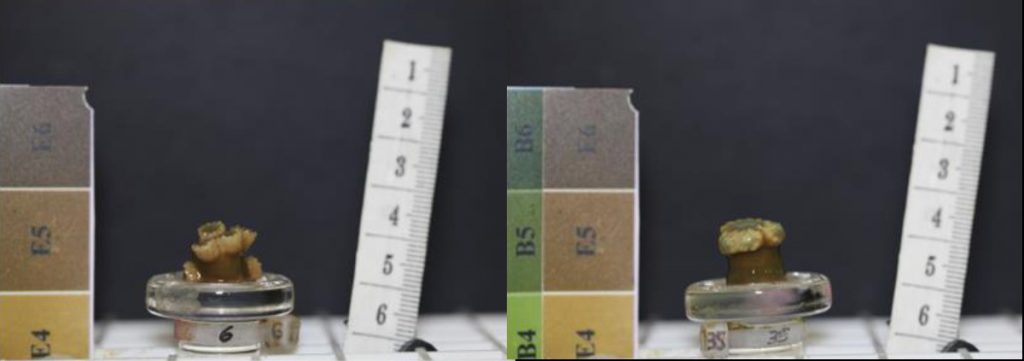
100-day frags of Duncanopsammia axifuga grown from polypless (left) and single-polyp (right) frags. Credit: Tagliafico et al. 2017
A new study is helping to shed light on the variables that influence growth rates in one of the aquarium trade’s most popular stony corals, Duncanopsammia axifuga (AKA Duncan’s Coral). Frags of this coral are always in high demand, making this an especially profitable species for aquaculturists to target, but what is the most efficient method for producing new polyps and large colonies? Tagliafico et al. 2017 set out to test this, examining the effect that feeding, orientation and polyp number had on the survival and growth of new frags. The branching nature of Duncan’s Coral means that there is naturally a fair bit of waste during the traditional fragging process, as, like the leaves on a tree, most of the polyps are found widely spaced around the periphery of the colony. The portions devoid of polyps wouldn’t seem like the best place to start a frag from, but it turns out that this assumption might be false.
When it comes to the number of new polyps produced and the speed at which these new polyps emerge, a polypless frag of D. axifuga performs considerably better than one started from a single polyp. On average, it takes 60 days for a single-polyp frag to begin budding off new growth, while the polypless frags start to show their first polyps at just 20 days. And these polypless frags produce a greater abundance of new polyps when compared to the single-polyp frags, even when those single-polyp frags are fed a diet of enriched brine shrimp.
When you think about it, this makes some intuitive sense. Duncan’s Coral is a strongly heterotrophic species which is anecdotally known for growing more quickly when fed, so a broken piece of coral without any polyps has a strong incentive to produce new growth so that it can resume feeding. On the other hand, a growing polyp might be better served putting the nutrients ingested towards increased mass and sexual reproduction. And this is borne out in some of the data from this study. For single-polyp frags that were unfed, there was no production of new polyps during the 100-day length of the experiment, and their overall growth rate was just one-half to one-third that of frags that were fed. A similar disparity in growth rates was also seen for the polypless frags, illustrating that fed polyps prefer producing increased mass to increased asexual growth.
A frag without polyps is clearly motivated to produce as many new buds as quickly as possible, but these are naturally going to be smaller growths when compared to a mature polyp that is regularly feeding. And that is the tradeoff that aquaculturists must make—is it better to incentivize as much new growth as possible so as to produce small, multi-polyped colonies more quickly, or is the goal to have frags with just a few robust polyps? It would be interesting to extend this experiment out beyond the 100-day period used in this study to see what sort of long-term effects these two fragging methods have on colony growth and shape. Do the many small polyps that quickly emerge from a polypless frag eventually produce a larger colony than frags begun from a single, slower-growing polyp? And how does this apply to other stony corals, particularly other sparsely-polyped LPS species like chalices?
- Tagliafico, A., Rangel, S., Kelaher, B., Scheffers, S. and Christidis, L., 2017. A new technique to increase polyp production in stony coral aquaculture using waste fragments without polyps. Aquaculture. (link)










0 Comments